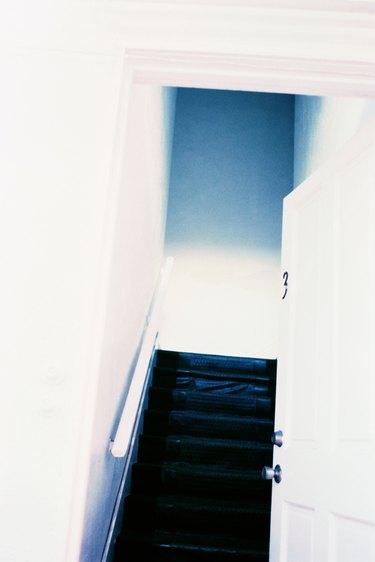
Heat naturally rises from the lower levels of a house upward, but a draft through an opened basement door cuts right into the warmth of the main floor. As the coolest level of a house, the basement will almost always send a draft into the house through its door. If the basement is not insulated and heated, the draft will be very cold during the winter months. Contain the heat of the house efficiently and inexpensively by blocking drafts from entering through its windows and doors.
A Well-Insulated Basement
Video of the Day
When the walls, floors and ceilings of a basement are properly insulated, heat does not easily escape its rooms, even if the only source of heat on that level is the furnace. Adding heating sources throughout the basement not only makes the sublevel space inviting and livable, it also mildly conducts heat to the upper levels, much like a floor with radiant heating. A warm, cozy basement does not cause the heating costs to rise, in fact it can save up to 20 percent of the house's heating cost. It may also cut down on the need for elevated temperatures on the main and upper levels of the house. In this case, whether the door is opened or closed, the heat in the house will be maintained.
Video of the Day
Closing the Door
Closing the door is the best option for a uninsulated basement that becomes as cold as the air and ground outdoors. With the door open, the house's main-level thermostat will sense the drop in temperature as the cool air from the basement circulates throughout the house. The thermostat will continue to signal to the furnace to run until the ever-cooling temperature of the room matches the temperature setting on the thermostat. This is a heating-cost nightmare when an unnecessary heating expenditure accumulates from a part of the house that lacks its own heating source. Cost the door, by all means, to cut back on the cost to heat the house.
Drafts Around the Door
Though closing the door helps to hold the cool draft from the basement back, some of this draft may still be felt around the closed door. Adding weatherstripping becomes a do-it-yourself solution to sealing the gaps around the door to correct this problem, and it will save up 18 percent of the heating bill. Some basement doors lead to a side or back door that opens out to the yard or driveway. This exterior door also becomes a source of a continuous draft, both to the main level and into the basement. For finished, well-insulated basements, this side-door draft that primarily flows downward becomes a problem source that causes the heating costs to rise. Weatherstripping is a solution here as well, but for both the basement and the side door to the outside, a new door featuring a pre-installed draft barrier is a wise, long-term investment for cutting the costs of heating the home.
Health Risks
In the winter months, cool, uninvited drafts through the house compromise health by encouraging illness. Coughs, colds, the flu, hypothermia, high temperatures, chest pain and stomach aches are all associated with cold weather in the fall and winter months. A warm house without drafts can help maintain the health of its inhabitants; correcting a draft problem from the basement is a step in the right direction.
- Energy Star: At Home Tips
- U.S. National Institutes of Health National Institute on Aging: Hypothermia -- A Cold Weather Hazard
- Consumers Energy: Controlling Your Energy Cost
- Ask the Builder: Basement Insulation
- CNN Money: Dodge the Draft and Cut Home Heating Costs
- Fox 40 WICZ TV: No-Cost Ways to Save Energy and Money
- Chiff.com: Cutting Home Heating Bills -- 50 Ways to Save Your Money
- Energy Star: Sealing Air Leaks -- Basement
- Health and Energy: Sealing Air Leaks